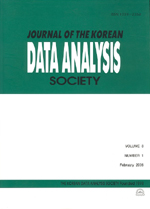예측성능 제고를 위한 범용크리깅과 지시크리깅의 결합
Combination of the Universal Kriging and the Indicator Kriging for Improving the Prediction Performance
- 한국자료분석학회
- Journal of The Korean Data Analysis Society (JKDAS)
- Vol.16 No.4
-
2014.081871 - 1884 (14 pages)
- 10

공간통계학(spatial statistics)에서 다루는 공간 자료(spatial data)는 연구에 관심이 되는 변수에 관한 측정값과 이를 관측하는 위치정보(location information)로 구성된다. 공간 자료를 이용한 공간상관성 분석을 수행함에 있어 위치 지점(location point)들 간의 상대적 위치 차이(거리와 방향)를 고려하게 된다. 지리통계학적 자료(geostatistical data)를 분석하는 경우 임의의 두 위치 지점 사이의 거리가 짧을수록 높은 상관성을 나타낼 수 있는 측도로 공분산모형(covariance model)을 사용한다. 이는 정상성(stationarity) 가정을 전제로 하는데 공간 상관성이 거리에만 의존하는 경우에는 등방성 공분산 모형(isotropic covariance model)을, 거리와 방향을 함께 고려하는 경우에는 비등방성 공분산 모형(anisotropic covariance model)을 적용한다. 임의의 위치 지점에 관한 미지의 관측값을 구하기 위한 공간 예측방법인 지시크리깅(indicator kriging)과 범용크리깅(universal kriging) 하에서의 등방성 및 비등방성 모형의 예측성능을 비교하고, 각각의 크리깅 결과를 이용한 최적의 예측결과를 얻기 위한 방법을 제안하고자 한다. 예측성능을 확인하기 위해 교차검증방법(cross-validation)을 적용하여 실제값과 예측값을 이용한 오분류를 평가하고자 한다.
A general spatial dataset composes of the measurements of our interest and their location information. When we usually analyze the data in order to detect the underlying spatial associations we take the relative positions (distance and angle) between arbitrary two measuring locations into account. It is naturally implied that, in practical geo-statistical data, spatial association increases as two locations get close to each other and decreases as they get distant. This phenomenon is modeled by a covariance model which is founded on the 2nd order stationarity. In this paper, we propose new techniques for producing more reliable spatial predictions as we combine prediction outcomes obtained from the universal kriging with those from the indicator kriging, each of which realized both an isotropic covariance model and a anisotropic one. In order to evaluate the prediction performances of our proposal, we employ leave-one-out cross-validation approach and compare the predictions with the observations in terms of accuracy, sensitivity, and specificity.
1. 서론
2. 등방성 및 비등방성과 크리깅
3. 실증연구
4. 결론
References
(0)
(0)